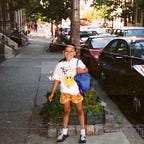Is Manhattan Set to Lose Its Most Affordable Neighborhood?
“You won’t find anything like this around.”
East Harlem landlord Hodge Rudy notes the architectural uniqueness of the 110th Street building he rents — the wooden window shutters, the sculpted ferns on his impeccable porch, a mosaic backyard garden. Rudy’s building is rare in Manhattan’s East Harlem neighborhood for a number of reasons. One reason — Rudy has barely increased the rents for his three tenants in over two decades. Surprising, given the increasingly desirable market value of his building.
In recent years, East Harlem, affectionately dubbed El Barrio— Spanish for ‘neighborhood’ — has managed the ongoing proliferation of rent increases that neighborhoods across New York City are experiencing. East Harlem is also among the handful of neighborhoods selected as part of Mayor Bill de Blasio’s controversial rezoning initiative. Much of the fear surrounding the city’s rezoning plan is the anticipated decrease in affordable residential units — something which has historically followed rezoning efforts that privilege free-market leasing.
One Manhattan neighborhood that isn’t currently slated for rezoning is TriBeCa, where the average rent price of a two-bedroom apartment is $7,594— the highest renting cost in Manhattan. Comparatively, East Harlem has the most affordable rents in the borough, with a two-bedroom apartment in El Barrio costing, on average, about $2,727 per month.
Unique to East Harlem is the high volume of public housing that caps the neighborhood’s overall average rent cost. Washington Heights and Inwood are both predominantly low-income neighborhoods, but it’s the large number of NYCHA units in East Harlem that keep the neighborhood relatively affordable.
Rudy says that he’s been a resident of East Harlem for 20 years. He bought the 110th Street building in 1996, which is something he says he doesn’t imagine the average East Harlem resident can currently do, because “the [housing] costs are too high now.”
The rate of homeownership in Harlem has decreased in recent years, a fact further complicated by a rezoning plan that some are calling upzoning.
Upzoning — essentially, building taller commercial and residential properties. The concern is that upzoning favors banks and real estate monopolies, considering the average East Harlem resident likely can’t afford to build a 30-story apartment building.
For rezoning defenders, public housing should function as a safety net to prevent the displacement of the established population from their developing neighborhood. In a case some make for gentrification, the justification for rezoning lays in its potential to benefit lower-income communities by bringing in more retail establishments, cleaner streets, and socioeconomic diversity.
With the expanding of free-market housing in East Harlem, public housing is increasingly becoming the desired residential option for locals who want to remain in the neighborhood. The current state of affordable housing in New York City exists as a veritable lottery, and as rezoning promises preservation and the development of more mixed-income residential buildings, finding financially manageable housing in East Harlem may become more difficult for low-earning residents.
For Rudy, his decades-long foothold in East Harlem is something that demands recognition. Pointing to his impeccable front-porch garden, Rudy says, “It’s important to keep this up. Caring for this place, no one else is doing this.”
New Harlem World covers stories related, but not limited to displacement, gentrification, and social unrest in Upper Manhattan and the South Bronx. You can follow Martika Ornella on Twitter @martikaornella, or email her at martika.wilson@journalism.cuny.edu.
